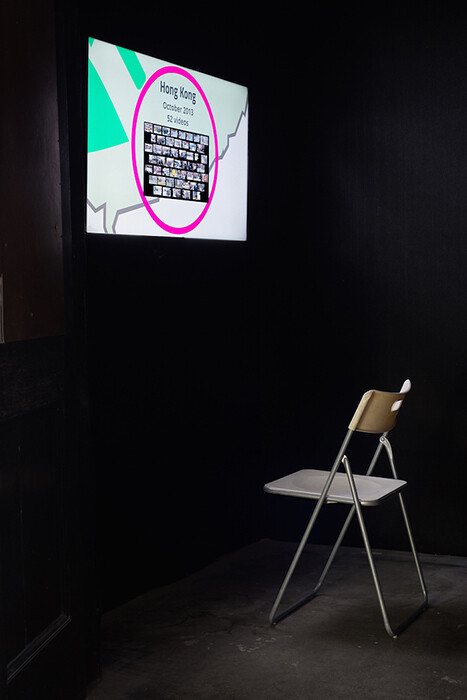An exhibition title containing a phrase like “Vive Le Capital” suggests a degree of irony in its subject matter. With a roster of some 24 artists and ambitious claims of “exploring the omnipresent power of global finance,” one expects an assortment of vaguely related works—critiques, interventions, manifestos—all of which gravitate toward a subject that itself seems almost redundant, as art and capital have always, of course, been inherently intertwined.
But “The Bank Show: Vive Le Capital” is appropriately situated and the selection of works judicious. The exhibition takes place at the former Bank Union building in Shanghai’s Bund district. Historically, the Bund sits as a remarkable surviving artifact of pre-communist internationalized China. The Bank Union, now home of the contemporary art space BANK, which also houses the offices of MABSOCIETY, a curatorial research platform and consultancy, was once a hub of global finance. Given this culturally rich and relevant site, MABSOCIETY, along with curators Wang Xin and Christoph Draeger, took a maximalist approach to exhibition-making, attempting to address the broad trajectory of contemporary art practices that have either directly challenged the system of global capitalism or else adopted its mechanisms in order to articulate art’s impotency in offering an alternative. Through the scope of these works, the exhibition considers the contradictions involved in such a task while successfully avoiding making any overwrought claims.
At the gallery’s entrance, hundreds of green American dollars flutter ceremoniously over viewers’ heads. The artist, Gianni Motti, conceived Money Box (2013–15) at the height of the financial crisis in 2009 when, upon receiving the budget for a commission, he applied the sum as his actual medium, reflecting both on the state of the economy at large as well as its implications within the cultural sector. Those who wish to purchase the work receive a check with which to withdraw the money for installation.
Motti and others in the show underscore the fact that the physical attributes of money belie its perpetually shifting nature. With the increasing financialization of markets, and crypto-currencies gaining tract, bills and coins remain effective sites for real-life intervention. Wang Sishun’s Uncertain Capital (2009) consists of a derelict lump of metal alloy. The work was initially composed from 300 yuan coins which the artist melted into a solid form and then sold, using the coin equivalent of the profits to create a new sculpture. This process was repeated several times, generating the large meteorite-like ingot, which lays precariously on its side. Through this cycle of production and consumption, Wang’s work also demonstrates the arbitrary relationship of capital to value.
Turning the materiality of money itself to question existing systems of value, the above pieces poetically skirt some of the pitfalls typically associated with interventionist works. Taking these tactics one degree further is Cai Guo-Qiang’s video Art Shopping Network (2005), the full recording of which played on a television monitor in the gallery’s front room. The artist exploded defunct Shanghai gold yuan bank notes—a currency issued in 1948, which was used for just 10 months before devaluing 20,000 times—and then sold them on a popular Taiwanese shopping channel, relegating the act to the realm of pure spectacle. The recording also pays homage to Chris Burden’s 1977 television piece Full Financial Disclosure, in which the artist read out his yearly earnings and expenditures on a commercial slot purchased on public access TV—a reference that makes apparent how few artworks today come close to Burden’s level of candidacy and mass appeal.
The power of media to disseminate and redistribute power is another major focus at “The Bank Show.” Kevin B. Lee’s Transformers: The Premake (2014) compiles 355 YouTube videos of amateur footage taken during the making of the fourth installment of the blockbuster franchise series Transformers. Using a “desktop documentary” technique, which employs screen-capture technology to communicate the experiential nature of the internet, Lee invokes a steady stream of commentary regarding notions of intellectual property and the weight of the market on creative discourse. Hollywood now counts China as a major source of revenue and has since taken to casting Chinese actors and including footage shot in China in order to gain access to the mainland market. Among the captured scenes in Lee’s film is one where the actress Li Bingbing profusely thanks director Michael Bay for giving her the opportunity to debut internationally, while another shows Bay defending his choice to shoot in a rural Chinese landscape against claims that such a move pandered to the studio’s interest in gaining Chinese audiences.
The exhibition does have its fair share of interventionist works, however, including Christoph Draeger’s Underground Doomsday Vendor (2015), in which the artist and co-curator of the show infiltrated Mexico City’s black-market activities of bootleg CD, book, and DVD circulation on the city’s subway system, and also his Occupy Nothing (2015), a call for viewer participation in reciting a script in the style of protest chants. Another is Dieter Meier’s performance Two Words (1971), where the artist bought, for one dollar, the words “yes” or “no” from passersby on the streets of New York, which appears documented with photos and framed certificates of the answers. These works effectively trace the legacy of art addressing capitalism through direct action as opposed to theory or reference. As one-time events, much like Burden’s renegade act of transparency in the malaise of the post-depression of the late 1970s, these instances run the risk of slipping into the background and being all too easily forgotten. In their afterlife as artworks, they become consigned to staid gallery walls, further embedding their prescribed actions with neutralizing effect. This exhibition, therefore, also serves as an archive, however riddled with contradictions, while demonstrating the various ways in which artists continue to reinvent and repurpose the language of capital.









